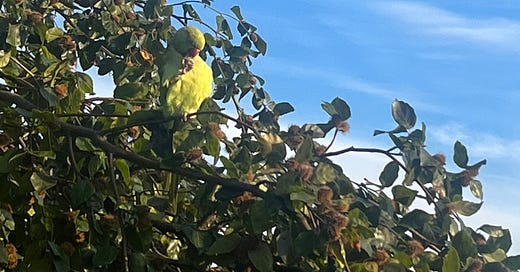No one knows exactly where they came from. They’re obnoxious. Their calls are nearly as loud as those of a cockerel and, to state the obvious, they’re as green than The Grinch, totally incongruous with London’s grey backdrop. They shouldn’t exist, they make no sense. But they’re in the tree outside my window everyday; somewhat blending with the summer trees, sticking out like bulbous Christmas decorations in the autumn and winter. It’s calming, sitting in my window ledge, trying to focus my eyes enough to see the micro-detail on their heads and wings. They remind me that special things do happen and manage to stick it out long enough to become part of your banal Thursday afternoon.
I’m writing about my 32,000+ green parakeets. That figure is the last one measured, from 2012, and I choose to believe it’s more now, having lived in London since 2010 and only remembering them as a rarity. It was once: “What the fuck, it’s a parrot”. Now it’s: “My guys, the green pigeons”.
Maybe it’s that I moved to the Blackheath/Greenwich area during the pandemic and their biggest population is found in South London. They were reportedly first seen in Dulwich in 1893 and then Brixton in 1894. Numbers remained very low until the mid-1990s when there were an estimated 1500 in the city. And now they’re thriving. I love that they love it near me—they probably appreciate the drama of the moor-like expanses of grass and regency homes here; it’s a place that’s as silly as they are.
I had a look into the mythology of their origins online: some say their ancestors escaped from the set of the Humphrey Bogart film, The African Queen, in Ealing Studios in 1951. One rumour is that they’ve mostly come from a pair of parakeets released by Jimi Hendrix in Carnaby Street in the 60s. The less interesting idea is that people just used to keep them as pets and they escaped. Academics who studied this phenomenon recently guessed that there may have been two spikes in numbers in 1929-31 and 1952 after sensationalised media reports of “parrot fever” outbreaks freaked people out enough to let their parrots fly free.
Regardless, the parrots managed to survive, despite being native to Africa and India, because they’re “generalist feeders”, which I guess means they’ll eat anything. Their only real predators are birds of prey.
Because this is Britain, where outsiders are met with suspicion and the nation’s deprivation mindset, it’s unsurprising that these legendary birds have some haters. They’re called an “invasive” species. They’re too noisy, which is the same reason every loser gives for wanting an end to fun. There’s fear their growth will impact the number of other birds—I don’t know how much I care about that! I want more of these green feral freaks in this sanitised, overpriced capital.
I found out recently that one of my very good friends is about to leave London for New York, which has made me feel as though I want to push the city away, to make it prove that there are reasons to be here (parakeets are a big one). That isn’t really how cities work though; you have to toil away in them, imprint yourselves, force yourself to be taken seriously as part of the surroundings, even and especially when you feel out of step with the people around you. You have to be feral and a little bit obnoxious.
§§§
Updates:
I have a piece coming out in the Observer Magazine this weekend about how I lost my intuition and what I did to try to get it back. I would love for you to get a copy if this sounds like something you’d be interested in. It’s psychologically, scientifically and spiritually intriguing imo, and comes complete with millennial blogger oversharing. It’s one of my favourite things I’ve worked on all year.
I also have a really long longread in British GQ (Sept issue) which is out now, about masculinity influencers and how fucked the contested state of masculinity is currently.






